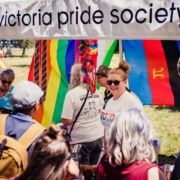What’s in a Name? | Queer Initialism Edition
What’s in a Name? | Queer Initialism Edition
May 1, 2021
by Ace Mann (they/them)
We evolve to stay relevant; our education, our skill sets, even our language—and the LGBTQ2S+ initialism should be no different. No matter how many letters we use, it’s nearly impossible to list each possible identity and we are left trying to encompass an often bypassed population with an imperfect initialism that is somewhat exclusionary. So… what can be done?
For those who may have read the March newsletter, there was a story on name changes, how to complete these for adults over the age of 19 in British Columia. But most importantly, it went through why names are so important to get right.
The Victoria Pride Society uses the initialism LGBTQ2S+ to refer to the rainbow communities as a whole. For those who don’t know, this stands for lesbian, gay, bisexual, trans, queer, and Two-Spirit communities. Depending on where you are across Canada—and certainly, the world—the order, or identified communities may change depending on perceived importance, value or statistically probably abundance of a community. There may be more or less letters, and they may repeat depending on the groups referenced. For example, the letter Q can stand for queer or questioning, the letter A may be added for asexual or agender or the letter I may be added for intersex. That is saying nothing about the infinite other possibilities or the nuances to each.
Some may be familiar with the term GSRD which stands for gender, sexuality, and relationship diverse. This term was introduced in an effort to work under intersectionality and include more people at once. Let’s talk a bit about why it’s a great new tool to describe our communities as one, why it’s a global initiative, and why it should matter to you.
What is GSRD?
GSRD is a term meant to replace the “alphabet soup” and incorporate all marginalized identities. Using the LGBTQQIIAAP2S+ is sure to omit many who might identify under the rainbow umbrella whereas GSRD is shorter but more inclusionary. This means it’s easier for our allies to get right, provides less struggle among ourselves when deciding which letters to use, and it pre-emptively includes future populations or groups that we might not yet have terminology for.
We fly the rainbow as our colours because our identities are a spectrum. A spectrum is not limited to a specific set of values, but rather is a continuum that can vary without specific steps, from one end to another. Like the rainbow, the GSRD initialism gives room for a spectrum without calling out individual identities.
Why GSRD?
As queer individuals, we generally carry one unifying flag with six bands of colour and claim the rainbow for ourselves as it signifies a spectrum. Originally, the flag had 16 stripes but was pared down to the modern six but it’s not done changing yet! Some add the black and brown stripes above the red to include BIPOC communities, some add a triangle of trans colours coming in from the side, and there are many others! If the flag can change over time, why not language? Evolution—change—brings with it the opportunity to reflect and rebuild in a way that suits a need better, to adapt to changing conditions, to flourish and not flounder.
If you are a part of the rainbow community in any way, you have likely faced some form of gatekeeping at some point. You may not fall neatly into one of the four flagship queer identities of being lesbian, gay, bisexual, or trans. Or, if you do, maybe you’ve been told you’re not someone else’s idea of a [your identity here] so you can’t join in with the rest of your peers. Perhaps you’re not one of those four at all, or maybe you identify with a mix of them, or perhaps differently depending on the day? And how often have you seen relationship diversity being included in the regular initialism? But do we not accept all of our siblings who are polyamorous, have kinks, or enjoy non-monogamy?
Fitting into a specifically shaped LGBT box is likely not an option for many people.Using the term GSRD provides a wider umbrella and gives autonomy back to the individual. Gatekeeping is harder to accomplish when there are fewer fences.
How Do We Keep GSRD Queer?
Couldn’t anyone potentially consider themselves somewhere on the GSRD spectrum? Maybe! Is that so bad? In speaking to an elderly family member recently about Pride, they reflected that perhaps they might have lived a very different life if they had the information about the world then as they do today. “How many of us might have chosen different partners or felt like they could explore without limitations?” she asked.
Who is to say that more cishet people might know more about themselves if they were to find the lingo? But welcoming them under the rainbow umbrella doesn’t mean there is less room for us all, it’s more likely to encourage empathy and drive understanding. If we are all really a spectrum, the law of statistics states that the odds of being exclusively at one end is astronomical, so maybe most of us are queer! Interestingly, new studies are showing that approximately half of the younger generation considers themselves somewhere on the spectrum. Now consider how many people identified as queer even 50 years ago.
An op-ed from a woman in Winnipeg states that she will no longer be attending the Pride parades: she wants to “keep Pride queer!” She argues that GSRD “sanitizes” Pride and promotes the idea that it centers the idea that being straight and cis is the norm.
How does GSRD apologize for being queer where LGBT does not? LGBT calls people out instead of calling them in. For ages, being “straight” was statistically the “norm” because it was most prevalent but it doesn’t make it the basis for normality. It was just statistically more likely.
To be clear, in her story she also states that, as a cis, white lesbian, she has no problem with the LGBT alphabet soup so why would anyone else? Why would anyone who is a lesbian, a gay, a bisexual, or a trans person feel unseen? It could be argued that she may be missing the point. However, she does argue that Pride needs to be proud, unapologetic, and include all queer people by not leaving our identities and politics behind. In that, aren’t we all on the same page?
Giving autonomy back to the individual to say, “I’m queer, I’m GSRD.” lets them say a lot without having to sit down and spell out exactly how they fit into a specific box, or many boxes, or maybe none at all.
The point of the new initialism is having more representation, more colour, more identities, more inclusion, and not taking away anything from anyone. To paraphrase an idiom: Lighting someone else’s flame doesn’t dim your own, it just makes the world a brighter place.
Cultural Variation
Now that we’ve discussed a wide range of gender, sexual, and relationship variation, let’s also remind ourselves that this discussion is all taking place while using the colonial categorization of the gender binary, assuming the population is mainly monogamous, etc.
Especially as we settlers are on the traditional territories of the Lekwungen peoples, and not our own, the ideas we have about gender, relationships, and sexuality in North America, in Canada, in “BC” should be re-evaluated as we remind ourselves of this framing. We might think in colonial terms but not everyone does. Many cultures have more than two genders, some cultures do not practice monogamy. Categorizing someone’s sexuality as not “normal” is relative only to the population that surrounds it.
Using GSRD is a great option to better include everyone under the rainbow without calling out individual identities. Will it be the best choice forever? Maybe not! It might not even be the best choice now—but it’s a start. Language, like culture, like relationships, like our understanding of ourselves and the world, is always evolving. GSRD is a linguistic snapshot in time of what is important now. Inclusion is important now. GSRD is a simple, inclusive initialism gaining traction across the globe. At VPS, we’re going to start using it in conjunction with our LGBTQ2S+ and we encourage everyone to consider the benefits of doing the same.


